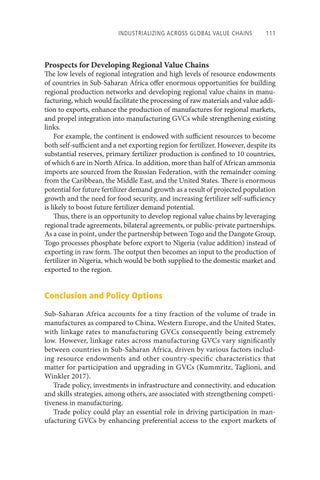Industrializing across Global Value Chains 111
Prospects for Developing Regional Value Chains
The low levels of regional integration and high levels of resource endowments of countries in Sub-Saharan Africa offer enormous opportunities for building regional production networks and developing regional value chains in manufacturing, which would facilitate the processing of raw materials and value addition to exports, enhance the production of manufactures for regional markets, and propel integration into manufacturing GVCs while strengthening existing links. For example, the continent is endowed with sufficient resources to become both self-sufficient and a net exporting region for fertilizer. However, despite its substantial reserves, primary fertilizer production is confined to 10 countries, of which 6 are in North Africa. In addition, more than half of African ammonia imports are sourced from the Russian Federation, with the remainder coming from the Caribbean, the Middle East, and the United States. There is enormous potential for future fertilizer demand growth as a result of projected population growth and the need for food security, and increasing fertilizer self-sufficiency is likely to boost future fertilizer demand potential. Thus, there is an opportunity to develop regional value chains by leveraging regional trade agreements, bilateral agreements, or public-private partnerships. As a case in point, under the partnership between Togo and the Dangote Group, Togo processes phosphate before export to Nigeria (value addition) instead of exporting in raw form. The output then becomes an input to the production of fertilizer in Nigeria, which would be both supplied to the domestic market and exported to the region.
Conclusion and Policy Options Sub-Saharan Africa accounts for a tiny fraction of the volume of trade in manufactures as compared to China, Western Europe, and the United States, with linkage rates to manufacturing GVCs consequently being extremely low. However, linkage rates across manufacturing GVCs vary significantly between countries in Sub-Saharan Africa, driven by various factors including resource endowments and other country-specific characteristics that matter for participation and upgrading in GVCs (Kummritz, Taglioni, and Winkler 2017). Trade policy, investments in infrastructure and connectivity, and education and skills strategies, among others, are associated with strengthening competitiveness in manufacturing. Trade policy could play an essential role in driving participation in manufacturing GVCs by enhancing preferential access to the export markets of

